
|
|

User quotes:
Absolutely Brilliant! Thank you for an absolutely incredible site. I have always known that I was red/green colourblind, but using your site I have successfully diagnosed myself as a protanope. The example pictures were absolutely spot on. At long last, when people ask me what it's like, I can show them rather than attempting to describe it. I hope that website and software designers alike will begin to use the tools you offer.
-Simon W.
|
|
|
|

|
|
Color blind image correction
(Run Daltonize online here)
One of the most common questions that we are asked is:
Is there a way to cure color blindness?
From a medical point of view, the answer is 'not really'. There are some
devices (colored contact lenses or filter spectacles) that are claimed to
improve the vision of color blind people but in general, people report
very mixed results with them. There is currently no effective way to recover
full trichromatic vision if you are red/green colorblind.
So in one sense, color blindness is 'incurable'. But a deeper question is
"what is color good for?". Apart from its aethetic appeal, seeing many
different colors allows us to distinguish things in the world. Take the
example below.
How many types of fruit is this man selling?
People with three different cone types ("trichromats") can see 5 distinct
piles of fruit on the ground.
From back to front, they look 'red', 'green', 'red', 'yellow' and 'light
orange'.
There are also some baskets on the shelf containing three piles of fruit.
|

|
But people with red/green color blindness usually
have trouble seeing all the different fruits.
They see something that can be simulated like this:
Note that there now seem to be only three or four different types of fruit
on the ground.
It is also hard to tell how many distinct piles of fruit there are on the
shelves.
|
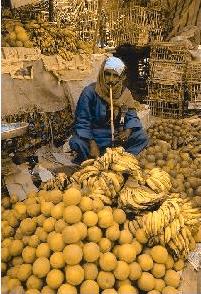
|
In some pictures, a lot of important information is conveyed by variations
in reds and greens. This is a real problem for color blind people who will
miss this information. The important point to understand is that the
'true' color of something may be irrelevant but the fact that it is different
from its surroundings is very important.
Here is another example:
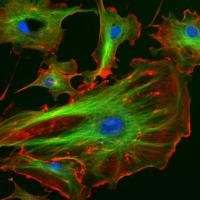
|
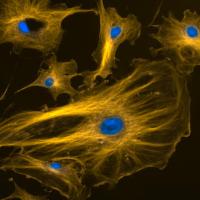
|
1) Cells labelled with three types of fluorescent
markers to show up three different structures.
|
2) Red/green color blind simulation of fluorescent
cell picture.
|
Here, a color blind scientist would be unable to tell the red and green
labels apart. They would miss important information about the structure
of the cells.
How to fix it?
We can use image processing techniques to improve this situation. There
are two ways that we can make information in pictures available to color blind
people.
1) The simplest way is simply to increase the red/green contrast in
the image. Many color blind people have some residual red/green discrimination.
Increasing the red/green contrast makes them more likely to see these types
of color variations.
2) We can analyze the information conveyed by variations in the
red/green direction and convert these into changes in brightness and/or
blue/yellow coloration. This allows us to map information from a color
dimension that is invisible to dichromats into those that they can see.
We call the combination of these two processes 'Daltonization' after John
Dalton, the British scientist who was one of the first people to investigate
color blindness.
The result of applying these algorithms is shown below.:
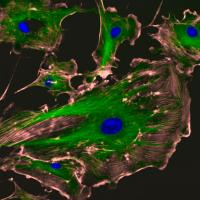
|
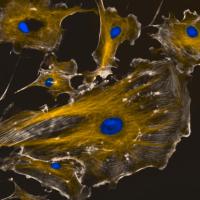
|
3) Daltonized version of three-color-labelled
fluorescent cells.
|
4) Dichromat (red/green color blind) simulation
of the Daltonized image.
|
Here, the algorithm has mapped changes in the reds and greens into slight
changes in brightness and bluishness. The result is that when viewed by
someone with color blindness, the different labelled structures in the cell
are clearly visible.
Here are some more examples. In each case, the images are numbered 1 to
4 where 1) is the original full-color image, 2) is a simulation
of the color-blind view of the full color image, 3) is the Daltonized
version of the full color image and 4) is the color blind simulation
of the Daltonized image showing improved red/green discrimination. To see
how well the Daltonization algorithm works for someone with color blindness,
compare images 2) and 4).
Example: Gauguin painting
In this case, the Daltonization transformation must be judged on a more
aesthetic level. While there is more 'information' present in image 4)
compared to image 2) the disruption in the color balance may be
unsettling (or fascinating) to some dichromats.
Here is an Ishihara plate - a common aid for diagnosing color blindness.
The number '45' in the center of the disk is invisible to someone
with red/green color blindness.
There are several things to note about this example. First of all, although
the enhancement of the red/green information in the Daltonized version is
striking, this is not a good general test of an algorithm to modify
images for color blind observers. The reason is that the Ishihara plates
are (deliberately) artificial images, and do not represent the range of colors
that people see in everyday life. It would be rather easy to design an algorithm
to 'improve' Ishihara plates (for example one that replaced all reds with
blues) that would nevertheless destroy other types of information in the
image. One nice feature of the Daltonization algorithm is that it analyses
the information content of the image beforehand and attempts to preserve
existing color variations.
Note also that the Daltonizing algorithm does not enable people to
"pass" the Ishihara test in any way. It is a digital image processing technique
that can make print or video display more salient to color blind people without
distorting the color balance to an unnacceptable degree.
And finally, here's the fruit market we showed you at the start:
The different piles of fruit on the floor are now clearly visible in image
4).
What is it good for?
We envisage a number of applications for this algorithm. Here are some examples:
As part of a digital microscope (see the 'cells' example above): Color blind users could flick a switch
to improve the visibility of red/green fluorescent labels or intrinsic color contrast...
In digital video recorders and display systems: Viewers could turn on the Daltonize algorithm much as they
might
vary the brightness or volume using a remote control. Operating on a real-time video stream, the algorithm could
improve the appearence of TV for color blind viewers (for example, making sports teams playing in red strip on a green
field far more visible) without significantly disturbing the color balance for other members of the audience....
Computer display devices: Computer users could turn on the Daltonize algorithm from as part of their
computer video card controls. All output appearing on the monitor (including web-pages, videos and still images) would
automatically be processed and rendered more salient to dichromats.
Print media: Images can be Daltonized before printing. Print applications where legibility is essential (for
example, public safety documents, maps, technical instructions) can all be made more legible for color-blind users....
That's great! I'd like to use this algorithm.
You can play with the algorithm online on this web page. Please be aware that this page is taking a lot of hits at the moment and may seem a little slow to respond. If you have any particularly interesting images that you would like us to process, send them to us by email at info@vischeck.com and we will run them 'by hand'. Please keep them to a reasonable size :)
We would also like
to hear your feedback about this algorithm - especially if you are color blind. Let us know what you think!
If you would like to license the Daltonizing algorithm for use in your own
applications, please contact us at
daltonize_licence@vischeck.com.
|
|

